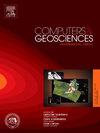BankfullMapper: a semi-automated MATLAB tool on high-resolution digital terrain models for spatio-temporal monitoring of bankfull geometry and discharge
IF 4.4
2区 地球科学
Q1 COMPUTER SCIENCE, INTERDISCIPLINARY APPLICATIONS
引用次数: 0
Abstract
Understanding river channel bankfull geometry is crucial for fluvial monitoring and flood prediction. The bankfull stage, typically reached every 1–2 years, marks when water spills onto the floodplain and strongly influences channel morphology. In our study, we present a novel approach for detecting river channel bankfull levels, utilizing a specialized MATLAB tool we developed, called BankfullMapper. The tool divides rivers into evenly spaced sections and computes a hydraulic depth function, plotting elevation above the thalweg against the area-to-width ratio. Bankfull levels are identified through (i) the lowest breakpoints from the thalweg or (ii) the most prominent breakpoints. Using Manning’s equation, the tool also estimates bankfull discharge.
We applied the method to two Italian rivers with contrasting hydrological settings: the single-channel Potenza River and the braided-to-wandering Marecchia River. Potenza was used for checking the tool's spatial analysis capability, while Marecchia served for spatio-temporal testing (2009 vs. 2022). Modelled bankfull extents were validated against expert-mapped active channel polygons using accuracy, precision, sensitivity, and specificity metrics.
For Potenza, bankfull discharges (33.9–52 m3 s⁻1) closely matched gauge data (2010–2023) using Gumbel distribution. The method showed high accuracy (0.90–0.92), sensitivity (0.94–0.95), and specificity (0.89–0.92), with moderate precision (0.53–0.61). For Marecchia, sensitivity ranged from 0.63 to 0.92, specificity from 0.73 to 0.89, accuracy from 0.80 to 0.83, and precision from 0.56 to 0.65.
Overall, the semi-automated approach reliably captures spatial and temporal changes in bankfull geometry and discharge across diverse river systems. It performs best using the lowest morphological breakpoints and offers a robust, detailed tool for hydrological research and river management.
BankfullMapper:基于高分辨率数字地形模型的半自动化MATLAB工具,用于河岸几何形状和流量的时空监测
了解河道堤岸几何形状对河流监测和洪水预测至关重要。堤岸阶段通常每1-2年达到一次,标志着水溢出到洪泛区并强烈影响河道形态。在我们的研究中,我们提出了一种利用我们开发的专门的MATLAB工具BankfullMapper来检测河道堤岸水位的新方法。该工具将河流划分为均匀间隔的部分,并计算水力深度函数,根据面积与宽度的比例绘制出水面以上的高度。通过(i)从thalweg的最低断点或(ii)最突出的断点来确定银行水平。利用曼宁的公式,该工具还可以估算出银行的流量。我们将该方法应用于两条具有不同水文环境的意大利河流:单通道波坦察河和辫状徘徊的马雷基亚河。Potenza用于检查工具的空间分析能力,而Marecchia用于时空测试(2009年与2022年)。利用准确性、精密度、灵敏度和特异性指标,根据专家绘制的主动通道多边形验证建模的河岸范围。对于Potenza, bankfull流量(33.9-52 m3 s毒血症)与使用Gumbel分布的测量数据(2010-2023)非常吻合。该方法准确度高(0.90 ~ 0.92),灵敏度高(0.94 ~ 0.95),特异度高(0.89 ~ 0.92),精密度中等(0.53 ~ 0.61)。对于孕妇,敏感性为0.63 ~ 0.92,特异性为0.73 ~ 0.89,准确度为0.80 ~ 0.83,精密度为0.56 ~ 0.65。总体而言,半自动化方法可靠地捕获了不同河流水系的河岸几何形状和流量的时空变化。它在使用最低形态断点时表现最佳,并为水文研究和河流管理提供了一个强大而详细的工具。
本文章由计算机程序翻译,如有差异,请以英文原文为准。
求助全文
约1分钟内获得全文
求助全文
来源期刊

Computers & Geosciences
地学-地球科学综合
CiteScore
9.30
自引率
6.80%
发文量
164
审稿时长
3.4 months
期刊介绍:
Computers & Geosciences publishes high impact, original research at the interface between Computer Sciences and Geosciences. Publications should apply modern computer science paradigms, whether computational or informatics-based, to address problems in the geosciences.
 求助内容:
求助内容: 应助结果提醒方式:
应助结果提醒方式:


